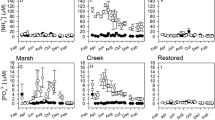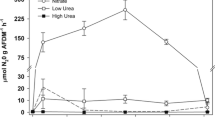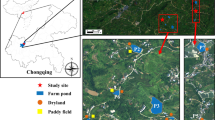Abstract
The conversion of undisturbed coastal regions to commercial and suburban developments may pose a threat to surface and groundwater quality by introducing nitrate-nitrogen (NO3 −-N) from runoff of land-applied wastewater and fertilizers. Microbial denitrification is an important NO3 −-N removal mechanism in coastal sediments. The objective of this study was to compare denitrification and nitrate conversion rates in coastal sediments from a golf course, suburban site, undeveloped marsh, and nonmarsh area near rapidly developing Hilton Head Island, South Carolina. Nitrous oxide was measured using gas chromatography and nitrate and ammonium concentrations were measured using a flow injection autoanalyzer in microcosms spiked, with 50 μg NO3 −-N gdw−1. The two marsh sites had the greatest ammonium production, which was correlated with fine sediment particle size and higher background sediment nitrate and surface water sulfate concentrations. The golf course swale had greatest denitrification rates, which were correlated with higher total carbon and organic nitrogen in sediments. Nitrate was consumed in golf course sediments to a greater extent than in the undeveloped marsh and upland freshwater sites, suggesting that the undeveloped sites and receiving estuaries may be more susceptible to nitrate contamination than the golf course swale and marsh under nonstorm conditions. Construction of swales and vegetated buffers using sediments with high organic carbon content as best management practices may aid in removing nitrate and other contaminants from runoff prior to its transport to the receiving marsh and estuary.
Similar content being viewed by others
Literature Cited
Brunet, R. C. andL. J. Garcia-Gil. 1996. Sulfide-induced dissimilatory nitrate reduction to ammonia in anaerobic freshwater sediments.Federation of European Microbiological Societies Microbiology Ecology 21:131–138.
Chevallier, T., M. Voltz, E. Blanchart, J. L. Chotte, V. Eschenbrenner, M. Mahieu, andA. Albrecht. 2000. Spatial and temporal changes of soil C after establishment of a pasture on a long-term cultivated vertisol (Martinique).Geoderma 94:43–58.
Danielson, M. N. 1995. Profits and Politics in Paradise: The Development of Hilton Head Island. University of South Carolina Press, Columbia, South Carolina.
D’Haene, K., E. Moreels, S. D. Neve, B. C. Daguilar, P. Boeckx, G. Horman, andO. V. Cleemput. 2003. Soil properties influencing the denitrification potential of Flemish agricultural soils.Biology and Fertility of Soils 38:356–366.
Dong, L. F., D. C. O. Thornton, D. B. Nedwell, andG. J. C. Underwood. 2000. Denitrification in sediments of the River Cole estuary, England.Marine Ecological Progress Series 203:109–122.
Griggs, E. M., L. R. Kump, andJ. K. Bohlke. 2003. The fate of wastewater-derived nitrate in the subsurface of the Florida Keys: Key Colony Beach, Florida.Estuarine Coastal and Shelf Science 58:517–539.
Holland, A. F., D. M. Sanger, C. P. Gawle, S. B. Lerberg, M. S. Santiago, G. M. Riekerk, L. E. Zimmerman, andG. I. Scott. 2004. Linkages between tidal creek ecosystems and the landscape and demographic attributes of their watersheds.Journal of Experimental Marine Biology and Ecology 298:151–178.
Jorgensen, K. S. 1989. Annual pattern of denitrification and nitrate ammonification in estuarine sediment.Applied and Environmental Microbiology 55:1841–1847.
Kaspar, H. F. 1983. Denitrification, nitrate reduction to ammonium, and inorganic nitrogen pools in intertidal sediments.Marine Biology 74:133–139.
Keith, S. M. andR. A. Herbert. 1983. Dissimilatory nitrate reduction by a strain ofDesulfovibrio desulfuricans.Federation of European Microbiological Societies Microbiology Letters 18:55–59.
Kelly-Gerreyn, B. A., M. Trimmer, andD. J. Hydes. 2001. A diagenetic model discriminating denitrification and dissimilatory nitrate reduction to ammonium in a temperate estuarine sediment.Marine Ecological Progress Series 220:33–46.
Kemp, M. J. andW. K. Dodds. 2002. The influence of ammonium, nitrate and dissolved oxygen concentrations on uptake, nitrification, and denitrification rates associated with prairie stream substrata.Limnology and Oceanography 47:1380–1393.
Koike, I. andA. Hattori. 1978. Denitrification and ammonia formation in anaerobic coastal sediments.Applied and Environmental Microbiology 35:278–282.
Lewis, D. W. 1984. Practical Sedimentology. Hutchinson Ross, New York.
Mallin, M. A., D. C. Parsons, V. L. Johnson, M. R. McIver, andH. A. CoVan. 2004. Nutrient limitation and algal blooms in urbanizing tidal creeks.Journal of Experimental Marine Biology and Ecology 298:211–231.
Mallin, M. A. andT. L. Wheeler. 2000. Nutrient and fecal coliform discharge from coastal North Carolina golf courses.Journal of Environmental Quality 29:979–986.
McGrath, C. andC. Zhang. 2003. Spatial distribution of soil organic carbon concentrations in grassland of Ireland.Applied Geochemistry 18:1629–1639.
Nijboer, R. C. andP. F. M. Verdonschot. 2004. Variable selection for modeling effects of eutrophication on stream and river ecosystems.Ecological Modeling 177:17–39.
Nowicki, B. L., E. Requintina, D. Van Keuren, andJ. Portnoy. 1999. The role of sediment denitrification in reducing groundwater-derived nitrate inputs to the Nauset Marsh estuary, Cape Cod, Massachusetts.Estuaries 22:245–259.
Pinay, G., T. O’Keefe, R. Edwards, andR. J. Naiman. 2003. Potential denitrification activity in the landscape of a western Alaska drainage basin.Ecosystems 6:336–343.
Statistical Analysis System (SAS) 1998.SAS/STAT User’s Guide, Version 6.12. Statistical Analysis System, Institute, Inc., Cary, North Carolina.
Sorensen, J. 1978. Capacity for denitrification and reduction of nitrate to ammonia in a coastal marine sediment.Applied and Environmental Microbiology 35:301–305.
Stevens, R. J., R. J. Laughlin, andJ. P. Malone. 1998. Soil pH affects the processes reducing nitrate to nitrous oxide and dinitrogen.Soil Biology and Biochemistry 30:1119–1126.
Tappin, A. D. 2002. An examination of the fluxes of nitrogen and phosphorus in temperate and tropical estuaries: Current estimates and uncertainties.Estuarine Coastal and Shelf Science 55:885–901.
U.S. Census Bureau. 2004. State and County Quick Facts. South Carolina: Population, percent change, 1990–2000. http:// quickfacts.census.gov/qfd/rankings/PL0120045r.html.
Van Dolah, R. F., D. E. Chestnut, J. D. Jones, P. C. Jutte, G. Riekerk, M. Levisen, andW. McDermott. 2003. The importance of considering spatial attributes in evaluating estuarine habitat condition: The South Carolina experience.Environmental Monitoring and Assessment 81:85–95.
Wang, F., J. S. Kim, S. P. Pelegri, andS. A. Macko. 2003. Denitrification in sediments of the Laurentian Trough, St. Lawrence Estuary, Quebec, Canada.Estuarine, Coastal and Shelf Science 57:515–522.
White, D. L., D. E. Porter, andA. J. Lewitus. 2004. Spatial and temporal analyses of water quality and phytoplankton biomass in a urbanized versus a relatively pristine salt marsh estuary.Journal of Experimental Marine Biology and Ecology 298:255–273.
Zar, J. H. 1996. Biostatistical Analysis, 3rd edition. Prentice Hall, Upper Saddle River, New Jersey.
Author information
Authors and Affiliations
Corresponding author
Rights and permissions
About this article
Cite this article
Tuerk, K.J.S., Aelion, C.M. Microbial nitrogen removal in a developing suburban estuary along the South Carolina coast. Estuaries 28, 364–372 (2005). https://doi.org/10.1007/BF02693919
Received:
Revised:
Accepted:
Issue Date:
DOI: https://doi.org/10.1007/BF02693919




